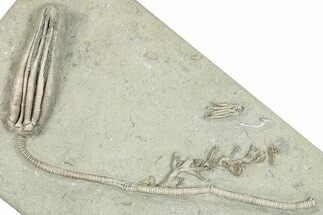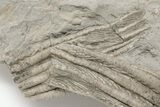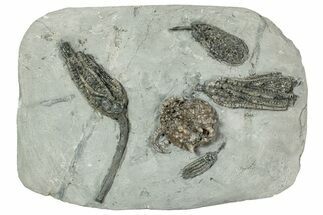This Specimen has been sold.
Two Fossil Crinoids (Parascytalocrinus?) - Crawfordsville, Indiana
This is a detailed association of two crinoids believed to be from the genus, Parascytalocrinus. The specimen was collected from the famous crinoid beds near Crawfordsville, Indiana. The quality of preparation on this fossil is exquisite - using skillful air-abrasion techniques under a stereo microscope. One crinoid is mainly intact, with only a few minor repaired cracks and the other is missing the calyx and a some of the anterior end of the arms. Overall a really fun association.
Crinoids from the Ramp Creek Limestone were likely buried in sediment from nearby deltas during storms. The resulting siltstone deposits are soft enough that fossils can be extracted in exquisite, three-dimensional relief.
Crinoids, sometimes commonly referred to as sea lilies, are animals, not plants. They are echinoderms related to starfish, sea urchins, and brittle stars. Many crinoid traits are like other members of their phylum. Such traits include tube feet, radial symmetry, a water vascular system, and appendages in multiples of five (pentameral). They first appeared in the Ordovician (488 million years ago) and some species are still alive today.
Crinoids, sometimes commonly referred to as sea lilies, are animals, not plants. They are echinoderms related to starfish, sea urchins, and brittle stars. Many crinoid traits are like other members of their phylum. Such traits include tube feet, radial symmetry, a water vascular system, and appendages in multiples of five (pentameral). They first appeared in the Ordovician (488 million years ago) and some species are still alive today.
SPECIES
Parascytalocrinus sp.?
LOCATION
Crawfordsville, Indiana
FORMATION
Edwardsville Formation
SIZE
Largest crinoid: 3.1" long, Overall specimen: 5.3 x 2.3"
CATEGORY
SUB CATEGORY
ITEM
#198577
We guarantee the authenticity of all of our specimens.
 Reviews
Reviews












